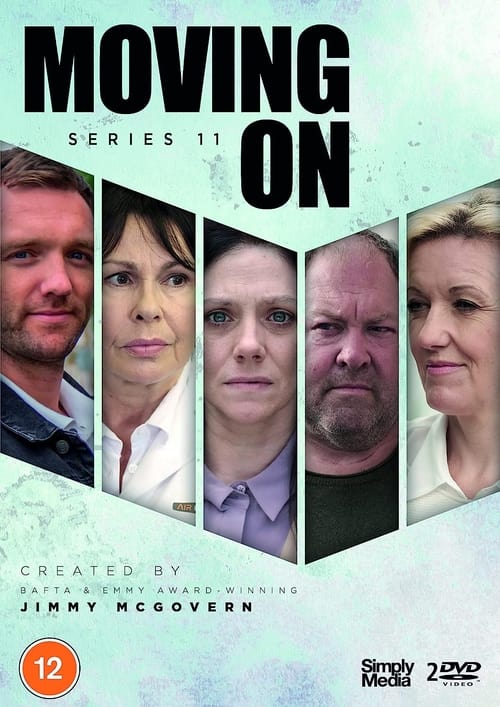
Ask Your Own Question
What is the plot?
In the first episode of "Moving On" Season 11, titled "Season 11," we are introduced to a character named Helen, who is grappling with the recent loss of her husband. The episode opens with Helen sitting alone in her living room, surrounded by memories of her late husband. She is visibly distressed, clutching a photo of them together. Her daughter, Lucy, enters the room, trying to comfort her. Lucy suggests that they should go out and do something to take Helen's mind off her grief, but Helen is resistant, preferring to stay in her cocoon of sorrow.
As the day progresses, Lucy insists on taking her mother out for a walk in the park. Reluctantly, Helen agrees, and they head out. The park is bustling with life, contrasting sharply with Helen's internal turmoil. While walking, they encounter a group of elderly friends of Helen's late husband, who reminisce about him fondly. This interaction triggers a wave of emotions in Helen, leading her to excuse herself and walk away, overwhelmed by the memories.
Later, Helen returns home and finds a letter addressed to her from her husband, which she had not opened before. The letter expresses his love and encourages her to find happiness again. This moment serves as a turning point for Helen, igniting a flicker of hope within her. She decides to take a step towards moving on, starting with cleaning out her husband's belongings.
In the following scenes, Helen begins the daunting task of sorting through her husband's things. As she goes through his clothes and personal items, she experiences a mix of sadness and nostalgia. Each item brings back memories, and she finds herself laughing and crying simultaneously. This cathartic process allows her to confront her grief more directly.
Meanwhile, Lucy is concerned about her mother's well-being and suggests that they attend a local support group for widows. Helen is initially hesitant but eventually agrees to go. At the support group, she meets other women who share their stories of loss. This connection with others who understand her pain provides Helen with a sense of community and support.
As the episode progresses, Helen begins to take small steps towards rebuilding her life. She starts volunteering at a local charity, which gives her a sense of purpose. During her time there, she meets a man named Tom, who is also dealing with his own loss. They strike up a friendship, and there is a palpable chemistry between them, though Helen is cautious about moving too quickly.
The climax of the episode occurs when Helen is faced with a decision about whether to pursue a romantic relationship with Tom. After a heartfelt conversation where they both share their fears and hopes, Helen realizes that she is ready to embrace life again. She takes a leap of faith and agrees to go on a date with Tom, symbolizing her commitment to moving forward.
The episode concludes with Helen and Tom sharing a light-hearted moment over coffee, laughing and enjoying each other's company. Helen's smile reflects her newfound hope and willingness to embrace the future, marking a significant step in her journey of healing. The final scene fades out as they walk together, hinting at the possibilities that lie ahead for both of them.
What is the ending?
In the final episode of "Moving On," Season 11, the story culminates with the characters facing their personal challenges and making significant decisions about their futures. The episode concludes with a sense of resolution for some, while others are left contemplating their next steps.
As the episode unfolds, we see the main characters grappling with their past choices and the impact those choices have on their current lives. The narrative weaves through their interactions, revealing their vulnerabilities and desires for change. By the end, some characters find closure, while others are left at a crossroads, hinting at the ongoing journey of moving on.
The episode opens with a quiet morning in a small, sunlit kitchen. The aroma of freshly brewed coffee fills the air as Sarah, a middle-aged woman, sits at the table, staring out the window. Her expression is pensive, reflecting the weight of her recent decisions. She has just ended a long-term relationship that left her feeling unfulfilled. As she sips her coffee, her phone buzzes with a message from her friend, urging her to join a local support group for those seeking to move on from difficult relationships.
Scene shifts to a bustling community center where the support group meets. Sarah arrives hesitantly, her heart racing as she steps inside. The room is filled with a diverse group of individuals, each sharing their stories of heartbreak and resilience. As Sarah listens, she begins to feel a sense of belonging. The warmth of the group encourages her to open up about her own experiences, and she shares her story, her voice trembling but growing stronger with each word. The scene captures the emotional release she feels, a pivotal moment in her journey toward healing.
Meanwhile, we see Tom, a retired man in his sixties, struggling with the loss of his wife. He spends his days in solitude, reminiscing about their life together. In a poignant scene, he visits their favorite park, where he sits on a bench, clutching a photograph of them from happier times. The camera lingers on his face, revealing the deep sorrow and longing in his eyes. As he watches families enjoying the day, a flicker of determination ignites within him. He decides to volunteer at a local charity, hoping to find purpose and connection once again.
The narrative then shifts to Lisa, a young woman in her twenties, who is at a crossroads in her career. She has been offered a job in a different city, but the thought of leaving her friends and family behind fills her with anxiety. In a heartfelt conversation with her best friend, they discuss the fear of change versus the excitement of new opportunities. Lisa's internal struggle is palpable as she weighs her options, ultimately deciding to take the leap and accept the job offer, symbolizing her desire to embrace growth and independence.
As the episode progresses, the characters' paths intertwine. Sarah, Tom, and Lisa find themselves at a community event organized by the charity where Tom volunteers. The atmosphere is lively, filled with laughter and music. Sarah and Tom strike up a conversation, bonding over their shared experiences of loss and the journey of moving forward. Their connection hints at the possibility of friendship and support in their respective healing processes.
In the final scenes, the characters reflect on their journeys. Sarah stands in front of a mirror, a newfound confidence radiating from her as she prepares for a date with someone she met at the support group. Tom, surrounded by new friends at the charity event, smiles genuinely for the first time in a long while. Lisa, excited and nervous, packs her bags for her new adventure, her heart filled with hope.
The episode closes with a montage of the characters embracing their new beginnings, each taking steps toward a brighter future. The screen fades to black, leaving viewers with a sense of optimism and the understanding that moving on is a continuous journey, filled with both challenges and triumphs.
Is there a post-credit scene?
In "Moving On," Season 11, there are no post-credit scenes. Each episode concludes without additional content after the credits, focusing instead on the main narrative and character arcs presented throughout the episode. The series maintains a straightforward storytelling approach, emphasizing the themes of personal growth and the complexities of relationships without the inclusion of post-credit moments.
What are the main character arcs in Season 11 of Moving On?
In Season 11 of Moving On, the character arcs are deeply intertwined with personal growth and the challenges of moving forward in life. Each episode features different characters facing unique dilemmas. For instance, in the episode titled 'The Last Goodbye', we follow a woman named Sarah who struggles with the loss of her mother and the impact it has on her relationships. Her journey is marked by emotional turmoil as she navigates her grief while trying to reconnect with her estranged sister. Meanwhile, in 'The New Start', a man named Tom grapples with the decision to leave his long-term job to pursue a passion for painting, reflecting his internal conflict between security and fulfillment.
How does the character of Sarah cope with her mother's death in Season 11?
Sarah's coping mechanism is portrayed through a series of poignant scenes that highlight her emotional struggle. Initially, she isolates herself, avoiding interactions with friends and family, which leads to feelings of loneliness. As the episode progresses, she begins to confront her grief by visiting her mother's favorite places, where flashbacks reveal their close bond. These moments are filled with nostalgia and sorrow, showcasing her internal battle. Ultimately, Sarah finds solace in writing a letter to her mother, expressing her unresolved feelings, which serves as a cathartic release and a step towards healing.
What conflict does Tom face regarding his career in Season 11?
Tom's conflict revolves around his desire to leave a stable but unfulfilling job to pursue his passion for painting. This internal struggle is depicted through scenes of him at work, where he appears disengaged and frustrated. His interactions with colleagues reveal their expectations for him to remain in a secure position, which heightens his anxiety about making a change. The turning point comes when he attends an art exhibition that reignites his passion, leading to a climactic moment where he must choose between comfort and his true calling. The emotional weight of this decision is palpable, as Tom grapples with fear of failure and the desire for personal fulfillment.
How does the episode 'The Last Goodbye' explore family dynamics?
In 'The Last Goodbye', family dynamics are explored through the strained relationship between Sarah and her sister, Emma. Their interactions are fraught with tension, stemming from unresolved issues related to their mother's illness. The episode uses flashbacks to illustrate their childhood bond, contrasting it with their current estrangement. Key scenes depict heated arguments and moments of vulnerability, revealing their differing coping mechanisms. As the story unfolds, a pivotal scene occurs when they are forced to confront their shared grief during a family gathering, leading to a breakthrough in their relationship as they begin to understand each other's pain.
What role does the setting play in the emotional journeys of the characters in Season 11?
The setting in Season 11 plays a crucial role in amplifying the emotional journeys of the characters. For instance, the use of familiar locations, such as Sarah's childhood home and Tom's art studio, serves as a backdrop for their introspection and growth. The contrast between the bustling city life and the serene countryside where Tom finds inspiration highlights his internal conflict. Additionally, the changing seasons throughout the episodes symbolize the characters' transitions; for example, the vibrant colors of autumn reflect Sarah's gradual acceptance of her mother's death. Each location is carefully chosen to evoke specific emotions, enhancing the narrative's depth and resonance.
Is this family friendly?
"Moving On," Season 11, produced in 2020, generally explores themes of personal growth, relationships, and the complexities of life transitions. While the show is designed to resonate with a broad audience, including families, there are elements that may be sensitive for children or those who are particularly sensitive.
-
Emotional Struggles: Several episodes delve into characters dealing with grief, loss, and personal crises, which may be heavy for younger viewers or those who have experienced similar situations.
-
Relationship Conflicts: The show often portrays conflicts in relationships, including arguments and misunderstandings, which could be distressing for some viewers.
-
Mental Health Themes: Some storylines touch on mental health issues, which may be challenging for sensitive audiences to engage with.
-
Social Issues: The series addresses various social issues that may include themes of betrayal, infidelity, and moral dilemmas, which could provoke strong emotional reactions.
-
Mature Language: While not excessively explicit, there may be instances of mild language that some parents might find inappropriate for younger children.
Overall, while "Moving On" can be insightful and thought-provoking, it may contain elements that require parental guidance for younger viewers or those who are sensitive to emotional content.











